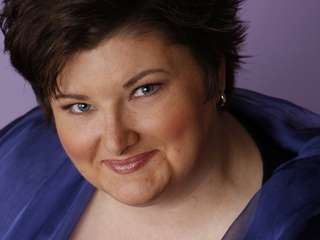|
Back
Big Voices For a Small Mass New York
Alice Tully Hall, LIncoln Center Complex
03/22/2010 -
Franz Liszt: Concert Paraphrase of Verdi’s “Rigoletto”, S. 434 (*)
Gioacchino Rossini: Petite Messe Solennelle
Tami Petty (Soprano), Jennifer Larmore (Mezzo-soprano), Vinson Cole (Tenor), Oren Gradus (Bass)
Anna Shelest, Kana Mimaki (*) (Pianos), Mark Kruczek (Harmonium), Voices of Ascension, Dennis Keene (Artistic Director and Conductor)

T. Petty (© The Sorel Association)
The right venue for Gioacchino Rossini’s lovely Mass, his last serious work, is in a church, with a full orchestra, as he had orchestrated the work before his death. Dennis Keene, the distinguished Artistic Director and Conductor of the 20-year-old Voices of Ascension, announced here, though that he would present the “original” version of Rossini’s work.
That wasn’t quite true. The original accompaniment of two pianos and a harmonium were used, yes. But where Rossini had specified a chorus of 12 – which included the four soloists, who would sing with the choir – we had the full Ascension Singers, about 40 singers. The quartet sat aside from the chorus and merely did their parts without working with the chorus at all
In a way, Mr. Keene’s chorus size was a practical one. Rossini’s premiere was in a much smaller Parisian salon, with voices and instruments probably muffled by the thick brocades, pictures, comfy antimacassars and Ottomans. (The Church banned performances, since it contained–oh horrors!!–women singers). It would have formed an organic musical unit. (And with Rossini himself turning the pages of the pianos, the collegial atmosphere would certainly have been enhanced.) So the fuller chorus here gave the voices a spacious room to sing their stuff.
But that didn’t allow for the pianos and harmonium, which sounded like this was a rehearsal for the orchestral version. The last time I heard this live was in the Macau Cathedral, with a full Portuguese orchestra and chorus, and it truly had a religious atmosphere.
Conductor Keene also added an intermission to divide the Mass, and this, I’m afraid, did little justice to Rossini’s very sincere attempt at a religious work. Between “the Holy Spirit in the Glory of God” and “Belief in One God, Makers of Heaven and Earth” should not admit instant coffee and shmoozing about the recession.
But these are tiny caveats, since the Voices of Ascension are a delightful choir. While their repertory is large, their reputation started with music of the Renaissance, and they still have that clarity of individual lines, with Latin that is easily understood. From the beginning, with the sopranos and tenors lined together, and altos with basses, the Rossinian comfortable composing showed itself. For the jocular, virtually opéra bouffe fugue in the “Cum sancto spiritu”, Mr. Keene led the choir with a sense of more fun than ecclesiastical reverence.
The four soloists, most veterans of the Metropolitan Opera and other operatic stages, were suitable for these operatic arias (Rossini’s “religion” was opera, so no reason why not!), but their personalities were as diverse as any theatrical characters.
Bass Oren Gradus had a ringing stentorian voice, though sometimes wobbling through his vibrato. Tenor Vinson Cole was intriguing. A fine tenor in his middle ranges, his voice became almost flutey when soaring upward. It was not unpleasant, but the voice seemed to come from another body. The famed Jennifer Larmore had no solos, but her duet in “Qui tollis peccata mundi” was soft, delicate, sensitive.
For sheer beauty of voice itself, I was absolutely stunned by Tami Petty. Was it Rossini style? I wouldn’t bother to answer that question. Such a beauty and purity of tone is so rare that I could only listen in ethereal pleasure.
Finally we have the instrumentalists. Regrets that I could hear little of the harmonium, but each the pianists had solos. Kana Mimaki played a delicious Liszt Verdi transcription (written about the same time as the Mass, in 1860), and Anna Shelest showed a different side of Rossini in her solo “Religious Prelude” before the finale.
This, in fact, was the most “religious” music of the jaunty Mass, with a near Bach-like counterpoint and smooth texture.
Yet one still thinks of Rossini as the master musical comic. He may even have put a little joke into the title. For his “petite” Mass is longer than most regular masses. Here, though, the instrumental forces were petites, though the vocal music was string and sometimes glorious.
Harry Rolnick
|